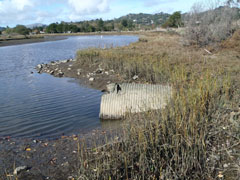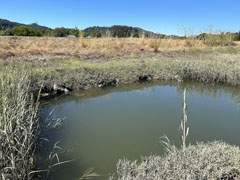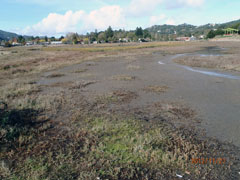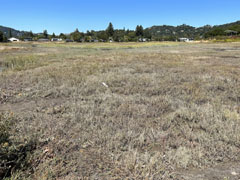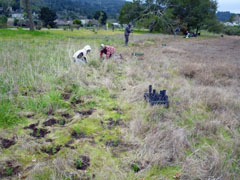Creekside Marsh at Hal Brown Park
Friends is involved with two projects at Creekside Marsh at Hal Brown Park. One project is to improve the health of the southeastern part of the marsh (the panhandle) and another to compensate for the unavoidable impacts of bridge construction.
Southeastern Creekside Marsh Culvert Replacement and Habitat Enhancement: : This project has two components. The first replaced the old, decomposing culvert just upstream of the Bon Air Bridge which muted tidal flow into the panhandle part of the marsh. Three larger parallel culverts were installed to convey enough tidal flow to match the equilibrium width of the channel in the marsh near the culvert.
The second component was to increase the amount of marsh vegetation. Tests showed that bare areas with no marsh vegetation had almost no pore space, too much gravel, high pH, and high salinity. Part of the poor soil was excavated and replaced by Young Bay Mud, which quickly sprouted pickleweed, saltgrass, and native cordgrass. Poor soil in another area was amended and planted with native plants.
Friends managed the project during the early phases, but culvert construction was managed by Marin County Parks. Friends has managed all of the planting. The project has been funded mostly from Community Services Area 17 monies used to maintain and enhance Creekside Park and by Regional Water Quality Control Board fines collected from the Ross Valley Sanitary District.
Habitat Enhancement to Compensate for Impacts of the Bon Air Bridge Replacement: The US Fish and Wildlife Service required the installation of gumplant and coyote brush to provide high-tide refugia for birds, especially Ridgway’s rails that use Creekside Marsh. The original planting was done in early January 2012. The drought resulted in high mortality of the young plants, and we continued to install more plants and sow seeds to meet the goal of a barrier between the marsh and the multi-use path along Corte Madera Creek. This work is implemented by Friends and funded by the City of Larkspur.
Larkspur Creekside Open Space
Friends, in collaboration with the Larkspur Creekside Homeowners’ Association, began a project in 2006 to remove invasive exotic vegetation from an area adjacent to a tidal wetland and to revegetate it with native species. Lisa Di Girolamo was the project manager. French broom, Harding grass, fennel, ice plant, pampas grass, and small acacias were removed, and treated areas seeded with the native grasses, creeping wild rye and meadow barley. Two problems made this a challenging site. First, we did not receive permission to remove some nearby tall acacias. Second, domestic geese that were being fed nearby grazed on the newly-planted native vegetation, doing severe damage. The geese have since been removed and the vegetation is improving. The project is maintained by Larkspur Creekside residents. Funding was provided by the U.S Fish and Wildlife Service Private Stewardship Grant Program, the Ross Valley Sanitary District, and Larkspur Creekside HOA.
Larkspur Creek
Begun in the fall of 1996, this cooperative endeavor with Redwood High School classes and the City of Larkspur has led to the revegetation of one bank of a largely tidal section of Larkspur Creek between Doherty Drive and Meadowood Drive. The artificial channel is about 1500 feet long, borders filled marshland, and bounds the Rose Lane housing development on two sides. We have removed acacia trees, pampas grass, broom, blackberry, and fennel, and replaced them with native plants. Since then, some blackberry, fennel, and acacias have returned. We hope to re-engage
Redwood High School students to do some maintenance on the project.
The exposed location and poor soil are challenges for revegetation, so plantings have limited to 6 species of trees (mainly coast live oak and willow), 7 species of shrubs and vines, and 4 species of grasses, sedges and rushes. Funding was provided by the Marin County Wildlife and Fisheries Commission. Complementing Friends’ work, the Rose Lane homeowner’s association manages a buffer of native vegetation between the creek and the homes. We can look forward to a healthy riparian corridor along lower Larkspur Creek.
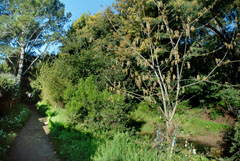
In the upper stretch of Friends’ project on Larkspur Creek, we replaced an avenue of acacia trees along the public footpath with oaks, box-elder, willows and buckeye.
Funding has been provided by the Marin County Wildlife and Fisheries Advisory Committee.
Complementing Friends’ work, the Rose Garden management has installed native trees on its side of the creek, so we can look forward to a healthy riparian corridor along lower Larkspur Creek.

